
You are reading:

You are reading:
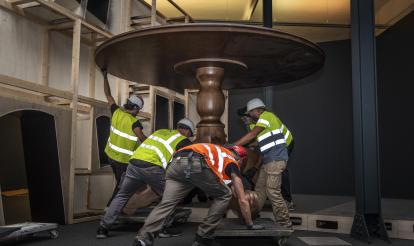
16.01.25
8 minutes readSend your questions to:
Various elements converge in scenographic design, all of which are essential for telling a story and directly appealing to emotions: the narrative conveyed by the collection of objects alongside the information on the walls, the scenographic recreations, the lighting, the sound and the story that visitors create as they move through the space. The scenographers Ignasi Cristià and Carles Berga, along with sound artist Clara Aguilar, share the significant role museography plays in CaixaForum exhibitions such as The worlds of Alice. Dreaming of Wonderland, Interior Berlanga. Cinema, life and humour and the upcoming Shipwrecks. Underwater archaeology.
A round table, an orange chair and a chequered floor. This Victorian interior, viewed from above, greets visitors who dare to fall down a rabbit hole after crossing the threshold of the exhibition The worlds of Alice. Dreaming of Wonderland, which will be on display at CaixaForum Barcelona and CaixaForum Madrid in 2025. As the pursuit of the White Rabbit progresses, that table transforms into a side table and a large dining table by distorting its proportions. What was once ordinary now becomes absurd in the illogical, ever-changing world Lewis Carroll envisioned in 1865. “This change of scale is the headline that tells us we’ve become Alice,” explains Ignasi Cristià, the exhibition’s scenographer.
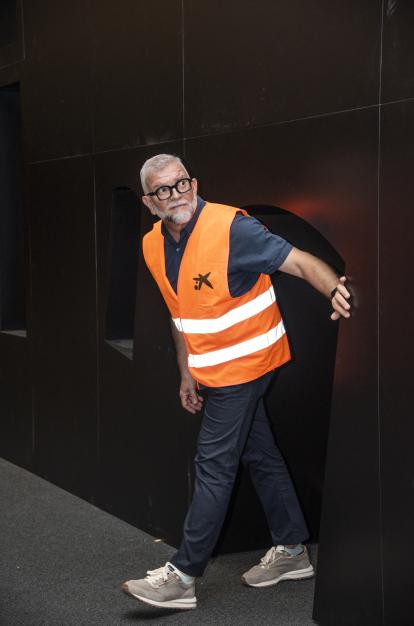
This initial immersion in The worlds of Alice, which will take on various forms throughout the exhibition, exemplifies what museography essentially is: a narrative that goes beyond the collection of objects and, through scenographic elements, transforms the audience into the protagonist of the story as they move through the space.
The space of an exhibition is not merely a container for objects; in Cristià’s view, it is “a scenography in itself” with its own voice and narrative. For this trained playwright with a well-established career in the field, theatre and museography share many similarities. “Both follow the same rules: we have a staging, actors and a performance,” he explains. “The key difference is that the protagonist isn’t on stage but is instead visiting the exhibition – that’s where the dramatic action unfolds, following the Aristotelian structure of introduction, development and resolution.”
If dramaturgy structures the narrative, it is architecture that gives it scale. For Carles Berga, a trained architect and responsible for the spatial design of the exhibition Interior Berlanga. Cinema, life and humour, which can be visited at CaixaForum Barcelona and CaixaForum Sevilla throughout this season, the physical framework shapes how visitors perceive the objects and the rooms they inhabit. “Scale is vital because you view the object from many different distances, and all of them need to be carefully considered,” he argues. Unlike spectators seated in an auditorium watching a story unfold “20 metres away”, visitors move freely through the space. “They control the pace: they can decide whether or not to enter a room.”
This is why he emphasises flexibility as a crucial factor in spatial design, allowing for multiple possibilities and suggesting rather than imposing. The primary objective, Cristià also argues, is to create an itinerary that promotes autonomy while ensuring the essence of the exhibition is not lost along the way.
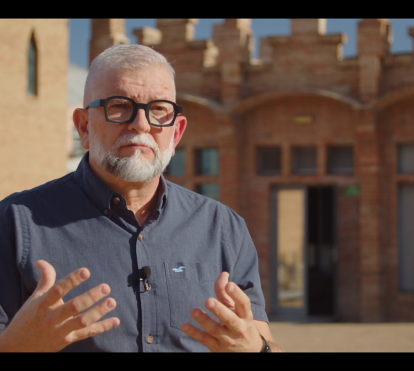
The alma mater of any exhibition is the script written by the curator, and the scenographer’s role goes far beyond mere translation. “It’s a process of listening and interpretation,” Berga emphasises, as it involves bringing “mental images” to life within a physical space. It is not about simply executing a predefined vision but rather opening a dialogue in which the initial ideas evolve. “For me, it’s a gift, I enjoy it a great deal,” he admits, referring to the act of making tangible something that previously only existed on paper. It is about “transforming their language into a space: a geometry, walls whose dimensions the playwright or curator had never specified.”
Respect for the original script is absolute. “Not a single comma should be altered in what it aims to convey,” clarifies Cristià. The dialogue with the curator – in this case, Kate Bailey, senior curator of design and scenography in the Theatre and Performance department at the Victoria & Albert Museum in London – is not so much a negotiation as a constant collaboration in which the team members share a common goal: to make visitors experience a set of sensations. “We all work in sync,” he assures.
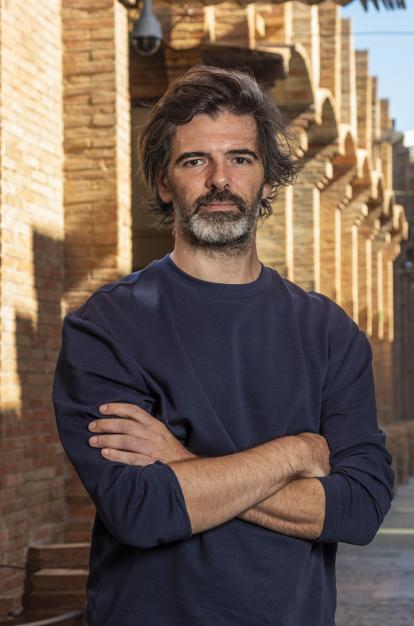
In this context, the scenographer acts as a mediator who shapes concepts into physical experiences without diverting focus from the narrative. “They can never compete with or cloud the message of the work. There’s a risk of providing unwanted information, and care must be taken to avoid falling into theatrical scenography; this is where the geography of the exhibition can have more personality,” both agree. The golden rule, warns Cristià, is balance: “To make a good dish, you must know the necessary ingredients and the precise amounts. All technologies are welcome, but always in the right measure so that the result doesn’t end up too salty.”
If there is one core element in spatial design, it is the visitors’ experience. The narrative within the walls of an exhibition is far from coincidental: it is carefully orchestrated to evoke, engage and transform the audience once they have left the exhibition space.
Like the polymorphic table at the entrance to The worlds of Alice, the foyer of Interior Berlanga. Cinema, life and humour is a statement of intent. The exhibition, which explores the various facets of the filmmaker’s life and legacy, welcomes visitors with an installation of cardboard boxes simulating his personal archive – previously unseen and revealed for the first time in this exhibition, supported by the ”la Caixa” Foundation in collaboration with the Spanish Film Archive. “The curiosity to discover what’s inside them leads you to cross the curtain,” Berga notes. For him, committed to providing an intimate view of this creator’s legacy, it was essential “not to betray the spirit of those objects.”
From this ambition, for example, came the decision to place the lottery ticket that Berlanga gave to his family precisely on the desk where he himself kept it. “It was essential to respect the object we were working with as much as possible, because Berlanga gave these objects value, as shown by the fact that he’d kept them all his life,” Berga explains, highlighting the necessary research to understand the essence of the objects, photographs, documents and materials on display. Together, they form a breadcrumb trail that visitors will be challenged to uncover.
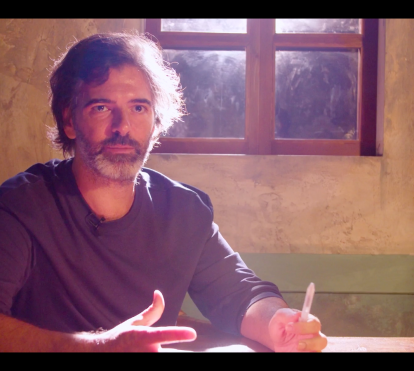
Activating emotions like excitement or surprise is a guarantee, says Cristià, that the visitor will continue wandering through the rooms. Knowing that they are part of the narrative, now transformed into Alice, they will encounter “a tree from which cinema screens hang, a tea party table where psychedelia is at play and giant playing cards behind which are objects related to the stage productions of Carroll’s classic in the theatre.”
The seduction of the visitors also involves the sense of hearing. Sound, notes musical artist Clara Aguilar, is a powerful ally in enchanting visitors and immersing them in the exhibition’s narrative. “It’s very tricky, like music, because it connects with our emotional side,” she explains. These months, Aguilar is composing the soundtrack for Shipwrecks. Underwater archaeology, which will open to the public in March 2025 at CaixaForum Girona. The exhibition, which advocates for underwater archaeology as a discipline to understand the history of humanity, will feature a scenography that evokes the ocean floor.
To shape the yet-to-be-formed soundscape, she recently boarded a boat with a team of archaeologists to capture “the sound of their work” using underwater microphones, with Cap de Creus as the backdrop, and transform it into music. The recording was made specifically for the project, Aguilar clarifies, but it has provided her with clues on which direction to take in her first foray into the museum field.
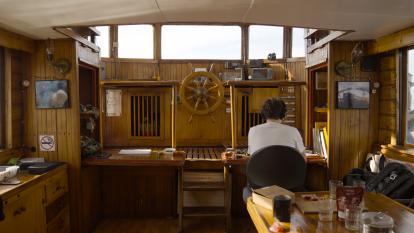
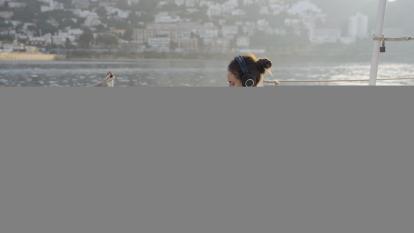
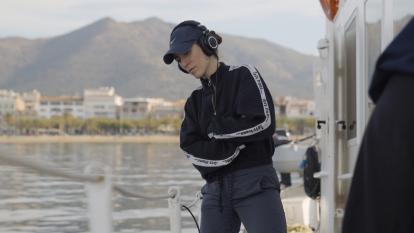
“Now, the next phase is to work with the plans to see the space and the available technical equipment, and from there to understand the narrative and what I can contribute.” The research led by Aguilar will steer towards a sound palette that, she hopes, will transport us beneath the sea as it reveals the rich memory it holds. Aware that the museum space is “full of accidents”, her focus is on observing the unpredictable reaction of the audience: “whether they’ll get close to the speakers, whether they’ll keep their distance or whether they’ll remain in a specific loop for a long time,” with the echo of the deep sea as their compass.
As reflected in the biographies of Cristià, Berga and Aguilar, it is at the intersection of their careers and creative disciplines where the richness of scenography emerges: a playwright who imprints emotions onto narrative structures, an architect who designs spaces meant to be inhabited and a composer who paints sounds to turn the exhibition into a musical canvas.
Together, they weave a dialogue in which the boundaries of each specialty dissolve, transforming every exhibition into a fertile ground for collaboration and the creation of experiences that, over time, take root in the memory of the visitors.